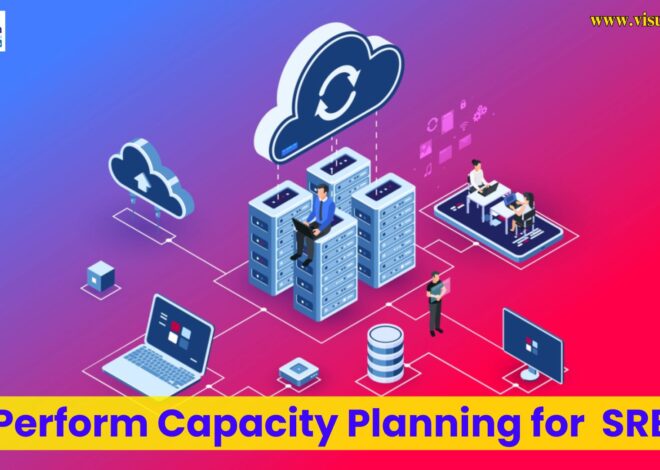
What Are the Best Practices for Capacity Planning and Scaling in SRE?
Introduction
Capacity planning and scaling are integral to ensuring the reliability, performance, and cost-effectiveness of any system. In Site Reliability Engineering (SRE), these practices are not just a function of infrastructure but a core aspect of delivering reliable services. Site Reliability Engineering Training emphasizes the importance of efficient capacity planning and scaling strategies to minimize downtime and optimize resources. This article explores the best practices for capacity planning and scaling in SRE, focusing on actionable insights and the significance of these processes in a real-world context.
Understanding Capacity Planning in SRE
Capacity planning involves determining the resources needed to handle current and future workloads effectively. It ensures that systems can meet demand without over-provisioning, which leads to cost inefficiency, or under-provisioning, which risks downtime.
Key Components of Capacity Planning:
- Workload Analysis:
- Analyze historical data to understand usage patterns.
- Identify peak usage times and ensure capacity accommodates these demands.
- Resource Utilization Monitoring:
- Use tools like Prometheus, Grafana, or New Relic to monitor CPU, memory, and storage usage.
- Set thresholds to trigger scaling actions before resources become a bottleneck.
- Forecasting and Trend Analysis:
- Leverage machine learning models for demand forecasting.
- Incorporate business growth predictions into capacity planning.
- Collaboration Between Teams:
- Encourage collaboration between product, development, and operations teams.
- Align on workload expectations and budget constraints.
Capacity planning is a critical component of Site Reliability Engineering Online Training, providing hands-on knowledge of tools and strategies for efficient resource management.
Best Practices for Scaling
Scaling ensures that your system can handle an increase or decrease in demand without compromising performance or reliability. There are two primary scaling strategies in SRE: horizontal scaling and vertical scaling.
Horizontal Scaling:
Adding more servers or nodes to distribute the workload.
- Advantages:
- Enhanced redundancy and fault tolerance.
- Flexible scaling without downtime.
- Best Practices:
- Use load balancers to distribute traffic evenly.
- Employ container orchestration tools like Kubernetes for seamless scaling.
Vertical Scaling:
Increasing the capacity of existing servers by adding more CPU, memory, or storage.
- Advantages:
- Simplifies infrastructure management.
- Suitable for applications that cannot be easily distributed.
- Best Practices:
- Monitor performance closely to avoid hitting physical limitations.
- Use automation tools for dynamic resource allocation.
Both strategies are covered extensively in SRE Certification Course training to equip professionals with the skills needed to implement these approaches effectively.
Automation in Capacity Planning and Scaling
Automation plays a pivotal role in modern capacity planning and scaling. Automated processes reduce human error, increase response time, and ensure systems are always prepared for workload fluctuations.
Key Automation Practices:
- Auto-scaling Groups:
- Configure auto-scaling policies based on metrics like CPU usage or request rate.
- Implement cool down periods to prevent unnecessary scaling actions.
- Infrastructure as Code (IaC):
- Use tools like Terraform or Ensile to define and manage infrastructure programmatically.
- Enable repeatability and version control for scaling operations.
- Continuous Performance Testing:
- Simulate workloads to test scaling mechanisms.
- Identify bottlenecks and refine scaling strategies.
Cost Optimization in Scaling
An often-overlooked aspect of scaling is cost management. Balancing performance and cost is a critical skill covered in Site Reliability Engineering Training.
Strategies for Cost-Effective Scaling:
- Spot Instances and Reserved Instances:
- Use cloud providers’ cost-effective options like AWS Spot Instances for non-critical workloads.
- Opt for reserved instances for predictable workloads.
- Right-Sizing Resources:
- Analyze underutilized resources and adjust configurations.
- Use monitoring tools to eliminate resource wastage.
- Hybrid Scaling Strategies:
- Combine horizontal and vertical scaling for maximum efficiency.
- Transition between strategies based on real-time needs.
Measuring Success in Capacity Planning and Scaling
To ensure the effectiveness of your capacity planning and scaling efforts, you need to define and measure key performance indicators (KPIs).
Essential KPIs:
- Uptime and Availability:
- Measure against SLAs to ensure reliability goals are met.
- Cost Per User:
- Optimize infrastructure spending relative to active users.
- Time to Scale:
- Evaluate how quickly your system can scale to meet unexpected demand.
Understanding these metrics is a fundamental aspect of Site Reliability Engineering Online Training, enabling engineers to align scaling strategies with business objectives.
Tools for Capacity Planning and Scaling in SRE
A wide range of tools simplifies capacity planning and scaling. SRE professionals often use the following:
- Kubernetes:
- Automates container scaling and management.
- Offers horizontal pod auto scaling for seamless scalability.
- AWS Auto Scaling:
- Provides dynamic scaling for AWS cloud services.
- Supports predictive scaling for anticipated demand.
- Data dog:
- Combines monitoring and capacity planning capabilities.
- Alerts for resource thresholds and provides insights into usage trends.
Hands-on experience with these tools is a vital part of SRE Course training, ensuring that engineers can implement and manage scaling efficiently.
Challenges in Capacity Planning and Scaling
While the benefits are substantial, capacity planning and scaling also come with challenges:
- Over-provisioning Risks:
- Excessive resource allocation leads to higher costs.
- Under-provisioning Risks:
- Insufficient capacity results in performance degradation and customer dissatisfaction.
- Unpredictable Traffic Patterns:
- Sudden spikes can overwhelm systems without proper forecasting.
Addressing these challenges requires expertise, which is imparted through the SRE Certification Course, equipping professionals with the skills to navigate complex scaling scenarios.
Conclusion
Capacity planning and scaling are essential pillars of Site Reliability Engineering, directly impacting system reliability and user satisfaction. By adhering to best practices, leveraging automation, and optimizing costs, organizations can ensure their systems remain robust and responsive to fluctuating demands. Site Reliability Engineering Training equips professionals with the skills and tools necessary to excel in these areas, making it an invaluable investment for businesses aiming to achieve operational excellence.
Whether you are pursuing an SRE Course or Site Reliability Engineering Online Training, mastering these concepts is crucial for delivering scalable, cost-effective, and reliable systems.
Visualpath is the Best Software Online Training Institute in Hyderabad. Avail complete Site Reliability Engineering (SRE) worldwide. You will get the best course at an affordable cost.
Attend Free Demo
Call on – +91-9989971070.
WhatsApp: https://www.whatsapp.com/catalog/919989971070/
Visit: https://www.visualpath.in/online-site-reliability-engineering-training.html



